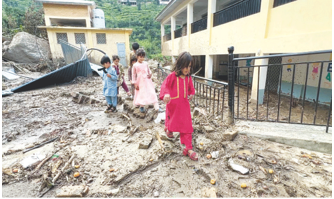INP-WealthPk
Abdul Ghani
The devastating floods of 2025 have delivered a crippling blow to Pakistan’s health and education systems, damaging more than 2,500 public facilities and jeopardising essential services for millions in affected areas, according to the Planning Ministry’s Preliminary Assessment Report.

The report documented the destruction of 243 health facilities and 2,267 schools across flood-hit regions, with combined financial losses estimated at Rs7 billion—Rs2 billion in health infrastructure and Rs5 billion in education. It warned that the social consequences of the disaster extend far beyond infrastructure damage, threatening to reverse years of human-development progress.
“The widespread destruction has significantly disrupted access to essential services, particularly in healthcare, water, sanitation and education,” the report stated. “These disruptions contribute to weakened community resilience and long-lasting consequences on learning outcomes.”
Health authorities are struggling to cope with surging disease outbreaks in overcrowded relief camps. The document cites diarrhoeal diseases, malaria, dengue fever, skin infections and respiratory illnesses as major threats, exacerbated by collapsed water and sanitation systems.
Women, children and the elderly remain the most vulnerable groups. “Over 662,000 people have received treatment in temporary medical camps established by provincial governments, NDMA and the armed forces,” the report said, warning that many rural communities remain inaccessible due to damaged roads and bridges.
On the education front, thousands of schools—especially in Punjab and Sindh—have either collapsed or been converted into temporary shelters. The prolonged closure has disrupted the academic calendar for hundreds of thousands of students. Officials fear increased dropout rates and widening learning disparities, particularly among girls in rural areas.
The Ministry emphasised that the education sector’s recovery will require both physical rebuilding and psychosocial support for children affected by trauma. “Reconstruction of schools must integrate disaster-resilient design—raised foundations, improved drainage and alternative energy supplies—to withstand future floods,” it recommended.
Health experts quoted in the report called for urgent rehabilitation of basic health units and rural health centres, alongside deployment of mobile clinics to underserved areas. They urged international agencies to provide vaccines, diagnostic kits and clean-water systems to prevent secondary crises.
The Planning Ministry described the floods as a “human-development emergency”, stressing that rebuilding hospitals and schools is central to restoring normal life. It urged federal and provincial authorities to allocate dedicated funds within the rehabilitation budget for health and education recovery.
Without swift intervention, the report cautioned, Pakistan risks long-term erosion of its social capital. “The indirect impacts—malnutrition, disease, and learning loss—may persist far longer than the physical reconstruction period,” it said.
The ministry pledged to ensure that future development planning includes stronger WASH systems, emergency-preparedness protocols in schools, and resilient public-health infrastructure.
“Rebuilding lives is as critical as rebuilding walls,” the document concluded, reaffirming the government’s commitment to protect human welfare amid an era of intensifying climate shocks.
Credit: INP-WealthPk













